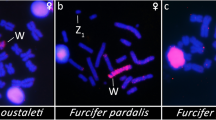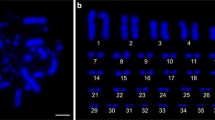Abstract
Populations of the gecko lizard Gekko hokouensis (Gekkonidae, Squamata) on Okinawajima Island and a few other islands of the Ryukyu Archipelago, Japan, have the morphologically differentiated sex chromosomes, the acrocentric Z chromosome and the subtelocentric W chromosome, although the continental representative of this species reportedly shows no sex chromosome heteromorphism. To investigate the origin of sex chromosomes and the process of sex chromosomal differentiation in this species, we molecularly cloned the homologues of six chicken Z-linked genes and mapped them to the metaphase chromosomes of the Okinawajima sample. They were all localized to the Z and W chromosomes in the order ACO1/IREBP–RPS6–DMRT1–CHD1–GHR–ATP5A1, indicating that the origin of ZW chromosomes in G. hokouensis is the same as that in the class Aves, but is different from that in the suborder Ophidia. These results suggest that in reptiles the origin of sex chromosomes varies even within such a small clade as the order Squamata, employing a variety of genetic sex determination. ACO1/IREBP, RPS6, and DMRT1 were located on the Z long arm and the W short arm in the same order, suggesting that multiple rearrangements have occurred in this region of the W chromosome, where genetic differentiation between the Z and W chromosomes has been probably caused by the cessation of meiotic recombination.




Similar content being viewed by others
References
Ansari HA, Takagi N, Sasaki M (1988) Morphological differentiation of sex chromosomes in three species of ratite birds. Cytogenet Cell Genet 47:185–188
Beçak W, Beçak ML (1969) Cytotaxonomy and chromosomal evolution in Serpentes. Cytogenetics 8:247–262
Beçak W, Beçak ML, Nazareth HRS, Ohno S (1964) Close karyological kinship between the reptilian suborder Serpentes and the class Aves. Chromosoma 15:606–617
Benton MJ, Donoghue PCJ (2007) Paleontological evidence to date the tree of life. Mol Biol Evol 24:26–53
Burt DW (2002) Origin and evolution of avian microchromosomes. Cytogenet Genome Res 96:97–112
Chen JC, Peng XB, Yu DW (1986) Studies on the karyotypes of three species of the genus Gekko. Acta Herpetologica Sinica 5:24–29
Ciofi C, Swingland IR (1997) Environmental sex determination in reptiles. Appl Anim Behav Sci 51:251–265
Cree A, Thompson MB, Daugherty CH (1995) Tuatara sex determination. Nature 375:543
de Kloet RS, de Kloet SR (2003) Evolution of the spindlin gene in birds: independent cessation of the recombination of sex chromosomes at the spindlin locus in neognathous birds and tinamous, a palaeognathous avian family. Genetica 119:333–342
Ezaz T, Quinn AE, Miura I, Sarre SD, Georges A, Graves JAM (2005) The dragon lizard Pogona vitticeps has ZZ/ZW micro-sex chromosomes. Chromosome Res 13:763–776
Ezaz T, Stiglec R, Veyrunes F, Grave JAM (2006a) Relationships between vertebrate ZW and XY sex chromosome systems. Curr Biol 16:R736–R743
Ezaz T, Valenzuela N, Grützner F, Miura I, Georges A, Burke RL, Graves JAM (2006b) An XX/XY sex microchromosome system in a freshwater turtle, Chelodina longicollis (Testudines: Chelidae) with genetic sex determination. Chromosome Res 14:139–150
Ferguson MWJ, Joanen T (1982) Temperature of egg incubation determines sex in Alligator mississippiensis. Nature 296:850–853
Griffiths R, Daan S, Dijkstra C (1996) Sex identification in birds using two CHD genes. Proc R Soc Lond B 263:1251–1256
Groenen MAM, Cheng HH, Bumstead N, Benkel BF, Briles WE, Burke T, Burt DW, Crittenden LB, Dodgson J, Hillel J, Lamont S, Ponce de Leon A, Soller M, Takahashi H, Vignal A (2000) A consensus linkage map of the chicken genome. Genome Res 10:137–147
Handley L-JL, Ceplitis H, Ellegren H (2004) Evolutionary strata on the chicken Z chromosome: implications for sex chromosome evolution. Genetics 167:367–376
Head G, May RM, Pendleton L (1987) Environmental determination of sex in the reptiles. Nature 329:198–199
International Chicken Genome Sequencing Consortium (2004) Sequence and comparative analysis of the chicken genome provide unique perspectives on vertebrate evolution. Nature 432:695–716
Iwabe N, Hara Y, Kumazawa Y, Shibamoto K, Saito Y, Miyata T, Katoh K (2005) Sister group relationship of turtles to the bird–crocodilian clade revealed by nuclear DNA-coded proteins. Mol Biol Evol 22:810–813
Janke A, Expenbeck D, Nilsson M, Arnason U (2001) The mitochondrial genomes of the iguana (Iguana iguana) and the caiman (Caiman crocodylus): implications for amniote phylogeny. Proc R Soc Lond B 268:623–631
Kawai A, Nishida-Umehara C, Ishijima J, Tsuda Y, Ota H, Matsuda Y (2007) Different origins of bird and reptile sex chromosomes inferred from comparative mapping of chicken Z-linked genes. Cytogenet Genome Res 117:92–102
Kumar S, Hedges SB (1998) A molecular timescale for vertebrate evolution. Nature 392:917–920
Kumazawa Y (2007) Mitochondrial genomes from major lizard families suggest their phylogenetic relationships and ancient radiations. Gene 388:19–26
Kumazawa Y, Nishida M (1999) Complete mitochondrial DNA sequences of the green turtle and blue-tailed mole skink: statistical evidence for Archosaurian affinity of turtles. Mol Biol Evol 16:784–792
Lang JW, Andrews HV (1994) Temperature-dependent sex determination in crocodilians. J Exp Zool 270:28–44
Matsubara K, Tarui H, Toriba M, Yamada K, Nishida-Umehara C, Agata K, Matsuda Y (2006) Evidence for different origin of sex chromosomes in snakes, birds, and mammals and step-wise differentiation of snake sex chromosomes. Proc Natl Acad Sci USA 103:18190–18195
Matsuda Y, Chapman VM (1995) Application of fluorescence in situ hybridization in genome analysis of the mouse. Electrophoresis 16:261–272
Matsuda Y, Nishida-Umehara C, Tarui H, Kuroiwa A, Yamada K, Isobe T, Ando J, Fujiwara A, Hirao Y, Nishimura O, Ishijima J, Hayashi A, Saito T, Murakami T, Murakami Y, Kuratani S, Agata K (2005) Highly conserved linkage homology between birds and turtles: birds and turtle chromosomes are precise counterparts of each other. Chromosome Res 13:601–615
Nanda I, Shan Z, Schartl M, Burt DW, Koehler M, Nothwang H-G, Grützner F, Paton IR, Windsor D, Dunn I, Engel W, Staeheli P, Mizuno S, Haaf T, Schmid M (1999) 300 million years of conserved synteny between chicken Z and human chromosome 9. Nat Genet 21:258–259
Nanda I, Zend-Ajusch E, Shan Z, Grützner F, Schartl M, Burt DW, Koehler M, Fowler VM, Goodwin G, Schneider WJ, Mizuno S, Dechant G, Haaf T, Schmid M (2000) Conserved synteny between the chicken Z sex chromosome and human chromosome 9 includes the male regulatory gene DMRT1: a comparative (re)view on avian sex determination. Cytogenet Cell Genet 89:67–78
Nanda I, Haaf T, Schartl M, Schmid M, Burt DW (2002) Comparative mapping of Z-orthologous genes in vertebrates: implications for the evolution of avian sex chromosomes. Cytogenet Genome Res 99:178–184
Nishida-Umehara C, Fujiwara A, Ogawa A, Mizuno S, Abe S, Yoshida MC (1999) Differentiation of Z and W chromosomes revealed by replication banding and FISH mapping of sex-chromosome-linked DNA markers in the cassowary (Aves, Ratitae). Chromosome Res 7:635–640
Nishida-Umehara C, Tsuda Y, Ishijima J, Ando J, Fujiwara A, Matsuda Y, Griffin DK (2007) The molecular basis of chromosome orthologies and sex chromosomal differentiation in palaeognathous birds. Chromosome Res 15:721–734
Ogawa A, Murata K, Mizuno S (1998) The location of Z- and W-linked marker genes and sequence on the homomorphic sex chromosomes of the ostrich and the emu. Proc Natl Acad Sci U S A 95:4415–4418
Ohno S (1967) Sex chromosomes and sex-linked genes. Springer, Berlin
Olmo E, Signorino G (2005) Chromorep: a reptiles chromosomes database. Internet references. Retrieved from: http://193.206.118.100/professori/chromorep.pdf
Ota H (1989a) A review of the geckos (Lacertilia: Reptilia) of the Ryukyu Archipelago and Taiwan. In: Matsui M, Hikida T, Goris RC (eds) Current herpetology in east Asia. Herpetological Society of Japan, Kyoto, pp 222–261
Ota H (1989b) Karyotypes of five species of Gekko (Gekkonidae: Lacertilia) from East and Southeast Asia. Herpetologica 45:438–443
Ota H, Hikida T, Nabhitabhata J, Panha S (2001) Cryptic taxonomic diversity in two broadly distributed lizards of Thailand (Mabuya macularia and Dixonius siamensis) as revealed by chromosomal investigations (Reptilia: Lacertilia). Nat Hist J Chulalongkorn Univ 1:1–7
Raymond CS, Shamu CE, Shen MM, Seifert KJ, Hirsch B, Hodgkin J, Zarkower D (1998) Evidence for evolutionary conservation of sex-determining genes. Nature 391:691–695
Sarre SD, Georges A, Quinn A (2004) The ends of a continuum: genetic and temperature-dependent sex determination in reptiles. BioEssays 26:639–645
Schmid M, Nanda I, Hoehn H, Schartl M, Haaf T, Buerstedde J-M, Arakawa H, Caldwell RB, Weigend S, Burt DW, Smith J, Griffin DK, Masabanda JS, Groenen MAM, Crooijmans RPMA, Vignal A, Fillon V, Morisson M, Pitel F, Vignoles M, Garrigues A, Gellin J, Rodionov AV, Galkina SA, Lukina NA, Ben-Ari G, Blum S, Hillel J, Twito T, Lavi U, David L, Feldman MW, Delany ME, Conley CA, Fowler VM, Hedges SB, Godbout R, Katyal S, Smith C, Hudson Q, Sinclair A, Mizuno S (2005) Second report on chicken genes and chromosomes 2005. Cytogenet Genome Res 109:415–479
Shetty S, Griffin DK, Graves JAM (1999) Comparative painting reveals strong chromosome homology over 80 million years of bird evolution. Chromosome Res 7:289–295
Shetty S, Kirby P, Zarkower D, Graves JAM (2002) DMRT1 in a ratite bird: evidence for a role in sex determination and discovery of a putative regulatory element. Cytogenet Genome Res 99:245–251
Shibusawa M, Nishibori M, Nishida-Umehara C, Tsudzuki M, Masabanda J, Griffin DK, Matsuda Y (2004) Karyotypic evolution in the Galliformes: an examination of the process of karyotypic evolution by comparison of the molecular cytogenetic findings with the molecular phylogeny. Cytogenet Genome Res 106:111–119
Singh L (1972) Evolution of karyotypes in snakes. Chromosoma 38:185–236
Smith CA, Sinclair AH (2004) Sex determination: insights from the chicken. BioEssays 26:120–132
Toda M, Hikida T, Ota H (2001) Discovery of sympatric cryptic species within Gekko hokouensis (Gekkonidae: Squamata) from the Okinawa Islands, Japan, by use of allozyme data. Zool Scr 30:1–11
Toda M, Sengoku S, Hikida T, Ota H (2008) Description of two new species of the genus Gekko (Squamata: Gekkonidae) from the Tokara and Amami Island groups in the Ryukyu Archipelago, Japan. Copeia 2008:452–466
Tsuda Y, Nishida-Umehara C, Ishijima J, Yamada K, Matsuda Y (2007) Comparison of the Z and W sex chromosomal architectures in elegant crested tinamou (Eudromia elegans) and ostrich (Struthio camelus) and the process of sex chromosome differentiation in palaeognathous birds. Chromosoma 116:159–173
Valenzuela N, Lance V (eds) (2004) Temperature-dependent sex determination in vertebrates. Smithsonian Books, Washington
van Tuinen M, Hedges SB (2001) Calibration of avian molecular clocks. Mol Biol Evol 18:206–213
Acknowledgments
This work was supported by Grants-in-Aid for Scientific Research (Nos. 15370001 and 16086201) from the Ministry of Education, Culture, Sports, Science and Technology, Japan.
Author information
Authors and Affiliations
Corresponding author
Additional information
Communicated by Y. Hiraoka
Rights and permissions
About this article
Cite this article
Kawai, A., Ishijima, J., Nishida, C. et al. The ZW sex chromosomes of Gekko hokouensis (Gekkonidae, Squamata) represent highly conserved homology with those of avian species. Chromosoma 118, 43–51 (2009). https://doi.org/10.1007/s00412-008-0176-2
Received:
Revised:
Accepted:
Published:
Issue Date:
DOI: https://doi.org/10.1007/s00412-008-0176-2




